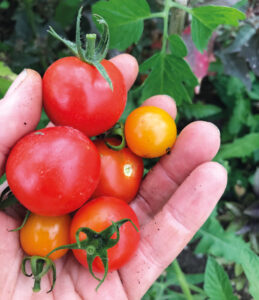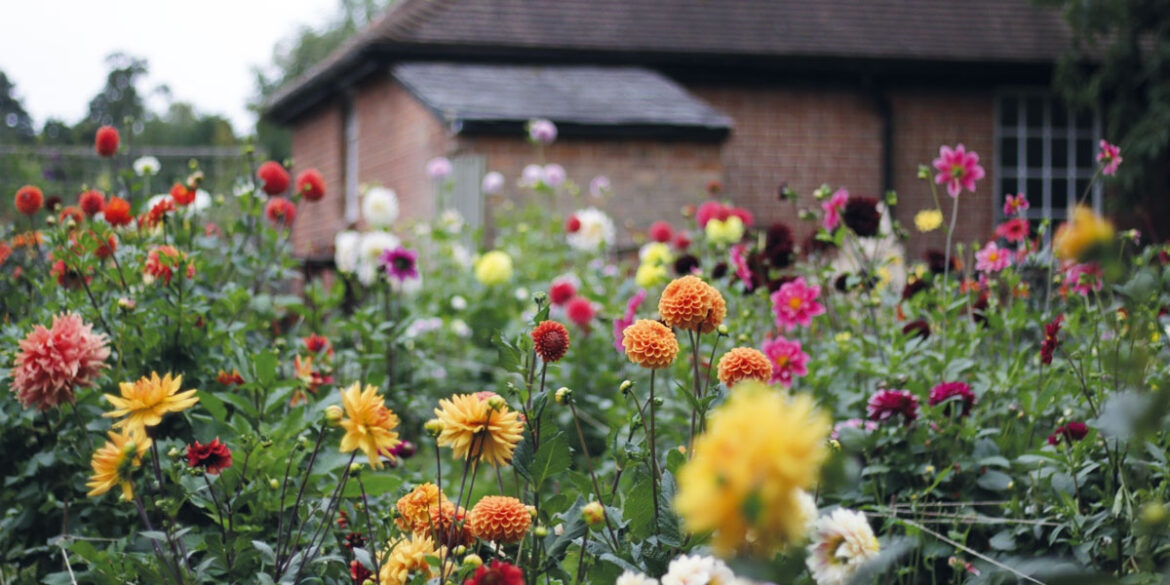Anna Taylor, owner of Anna’s Flower Farm in Audley End, shares what’s going on in the garden this month.
Turn on, tune in and drop out for the hazy holiday season. It’s not a vigorous time anywhere, let alone in the garden. For a blessed moment, one may have managed an interlacing of plants where the whole border rises and holds just for a moment – in the exact way you saw it do in a garden magazine – before an August storm crashes and flattens it! It feels like 5pm on the horticultural clock: just on the edge of a tantrum and a funny half hour; it really could go any way. If you know, you know.
So, enjoy it. I love that moment when it’s all a joyful tapestry of elbowing leaves. Pushing through dahlias up to my shoulders, border edges blurred by toppling nasturtiums, ferny vines of cosmos and sticky tobacco flower leaves. You need waterproofs to harvest in the mornings, heavy dew lying like precious jewels on the oversized leaves of squash, courgettes and self-seeded nicandra. By the afternoon, everything’s parched, and I can smell that late summer stuffy scent; a combination of hot, dusty pavements, sun lotion and musty tomato leaves.
 Vegetable plots and flower gardens are an embarrassment of riches. Where we gave earnest attention to the first peas or cut narcissus months ago, now it’s a job to keep up with harvesting. To prolong flowering into September, I must cut at least weekly, snipping spent ones before they run to seed, telling the plant: ‘You’ve done it, future offspring secured, no need to send more.’ But keeping them performing with a quenching feed (ideally a weak seaweed or comfrey tea sprayed onto leaves in the cool evening) and gathering of stems. In the afternoon, collect the seeds of those that you got to too late, shaking into envelopes and storing in the cool.
Vegetable plots and flower gardens are an embarrassment of riches. Where we gave earnest attention to the first peas or cut narcissus months ago, now it’s a job to keep up with harvesting. To prolong flowering into September, I must cut at least weekly, snipping spent ones before they run to seed, telling the plant: ‘You’ve done it, future offspring secured, no need to send more.’ But keeping them performing with a quenching feed (ideally a weak seaweed or comfrey tea sprayed onto leaves in the cool evening) and gathering of stems. In the afternoon, collect the seeds of those that you got to too late, shaking into envelopes and storing in the cool.
Take scented geranium, pelargonium and salvia cuttings from non-flowering stems and push around the edge of a pot of gritty compost. These take easily, securing tender plants that may be lost to the winter.
Sow perennial seeds this month, too – put into trays of compost and set aside in a sheltered spot out of the frying midday sun. Eryngium, achillea, echinacea and rudbeckia will all germinate well and grow over winter before planting out in the late spring. Perennials are the future.
Harvest tomatoes, beans and berries before they become overripe. Eating these straight off the plant convinced me growing your own gave a flavour utterly unrivalled by supermarket produce. It may be only a precious handful, but a sublime experience.
If it’s hot, plants may tire before their time, although I try to clear and sow a few green manure seeds in their place unless I have biennials of foxgloves, sweet rocket or wallflowers to plant instead. Green manures are new to me, but these grow, improving soil structure, fertility and water retention with little outside help. They keep soil active through the winter – or until you have something to replace them with. Remember, nature loves a vacuum.
 Or, sow winter salads into the warm soil. There are so many varieties that take little attention and fill gaps, like winter purslane, rocket and chicory. They’ll be the reason you’ll visit the garden in the winter, when this period of voluptuous excess will seem like a foreign country.
Or, sow winter salads into the warm soil. There are so many varieties that take little attention and fill gaps, like winter purslane, rocket and chicory. They’ll be the reason you’ll visit the garden in the winter, when this period of voluptuous excess will seem like a foreign country.
Anna runs Anna’s Flower Farm, where she writes, consults and teaches how to grow and arrange flowers. New ‘grow your own’ courses and flower-arranging classes start soon – head to annasflowerfarm.com

